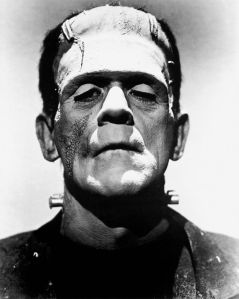In my 9-7-09 post, I discussed the guillotine and how quickly death came after decapitation. The post was titled Guillotine and Death: How Long Does It Take?
The French weren’t the only ones interested in the answer to this question. A report in the August 18, 1900 edition of The Journal of the American Medical Association (JAMA) discussed a recent report from Professor A. Hoche in which he described his experiments on two decapitated criminals.
“It’s alive!”
Who can forget the scene where Dr. Henry Frankenstein animates his monster with the power of electricity? Though the “Modern Prometheus” of Mary Shelley’s book is much different from the monster characterized by Boris Karloff in the classic 1931 movie, our collective mental image of the monster will always be Karloff. Just as Connery is Bond, Karloff is Dr. Frankenstein’s monster.

But truth and art are often not that far apart.
Dr. Hoche’s first experiment involved applying a powerful current to the freshly cut (just 3 minutes) spinal cord of a convicted criminal after his court-ordered decapitation. The effects were dramatic. The headless corpse responded immediately: the arms flexed, the hands clenched, the legs extended and spasmed, and even the chest expanded as if taking a breath. Bet that shocked the Professor and any onlookers. He noted that this reaction dampened with time and that after about 12 minutes no reaction occurred at all.
In the second experiment, he used a weaker electrical current and found that the response was much less. Both arms contracted as did the muscles of the chest and abdomen, but the legs remained motionless. Again the reaction lessened with time and at about 16 minutes no further reaction to the current occurred.
He also found that stimulating the brain itself did not cause any reaction.
He concluded that this loss of reactivity over time was due to blood loss and body cooling. The reason the brain did not react was that it lost blood and heat so rapidly that even two minutes was too long. Though his experiments were well-planned and conducted, his conclusions were erroneous. But he can be forgiven since he, nor anyone else at that time, had any real understanding of how the human neurological system worked.
What his experiments actually revealed was that different tissues and cell types within the body die at different rates after blood flow ceases. In all tissues, once blood flow is interrupted, the organ or tissue first begins to malfunction and if the deprivation continues they cells ultimately die.
The brain malfunctions and dies fairly quickly while the nerves and muscles take longer. The dogma is that if blood flow to the brain ceases, consciousness is lost in a very few seconds (this is the brain malfunction) and the brain cells die within 4 minutes. Nerves and muscles take much longer to malfunction and die.
In cardiology we routinely open closed arteries with angioplasty balloons and stents and do so very frequently after the artery has been closed for several hours. Here the golden rule is 4 hours, not 4 minutes, but that is highly variable. In the cath lab we might see that the area of the heart fed by the occluded artery will not contract well (the malfunction), but more often than not once the artery is opened this abnormal function resolves and the heart muscle survives, showing no evidence of residual damage. Not always but often.
So the brain malfunctions quickly and dies in a very few minutes; nerves and muscles take many minutes to malfunction and hours to die. Same process; different rates.
This is what Professor Hoche observed. The brain did not respond even after only two minutes; the nerves and muscles did, for 12 to 16 minutes anyway.
So the facial movements noted by those who observed guillotine executions were likely these types of residual neuromuscular actions and not a representation that the victim was still alive.
Or maybe they were—for a few seconds anyway.
On a literary and historical note, Frankenstein might never have been written had it not been for a volcanic eruption on the other side of the world. In 1815, Mount Tambora in Indonesia erupted with such force that it filled the air with millions of tons of ejected particulate matter. This rose into the high atmosphere, dropped world temperatures for many months and resulted in 1816 being called the “Year Without Summer.” Snow fell in New England in July!
During that summer, Mary Wollstonecraft Godwin, her lover and future husband Percy Bysshe Shelley, and Lord Byron settled into Villa Diodati on Lake Geneva. The summer was so cold and wet that they spent much of their time in the villa talking and telling stories. They decided to have a writing contest and see who could write the best short story. Mary’s story evolved into the classic Frankenstein; or the Modern Prometheus.
There has long been controversy over how Mary came up with such a story, She said it came to her in a “waking dream,” but some have suggested that her father had told her stories of a doctor who did such experiments and others have suggested that she and Shelley had actually visited Castle Frankenstein, the birthplace of Johann Conrad Dippel, a physician and alchemist who did indeed perform reanimation experiments on corpses. Either way she wrote a kick-ass story that has survived for nearly two centuries and will survive for many more.

























CSG
September 19, 2009 at 10:38 am
“Gothic” is an interesting movie about – among other things – the writing of Mary’s famous novel.
LikeLike
Helen
April 19, 2010 at 1:01 am
I am teaching Frankenstein to my class at the moment – this is very useful context and a very interesting read. Thank you.
LikeLike